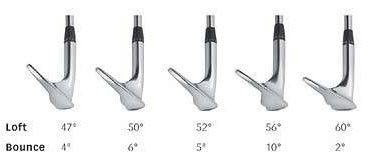Wedge Bounce Guide (A quick guide to what bounce to play in varying conditions)
Now you can buy online at www.truefitclubs.com
Why do I need a gap wedge?
Since the late 1970’s there has been a trend to stronger lofts in irons. The modern 6 iron is the same loft as a 4 iron from the 1970’s. Lofts in irons are 4 degrees apart so that you get a distance separation of 10 to 15 yards from club to club. So, for example, if you hit your 6 iron 165 yards, you may hit your 7 iron 150 to 155 yards, etc. Because of the lofts in iron sets being 4 degrees apart, a typical 9 iron is now 40 degrees and a pitching wedge (PW) is 44 to 46 degrees. But the lofts on standard sand wedges have not changed and are typically 54 to 56 degrees. This leaves a very large “gap” between the distance you will hit a PW and your sand wedge. Hence, the introduction of a gap wedge which is usually 50 to 52 degrees in loft. Another great wedge to have in your bag is the L wedge (Lob), which comes in either 58 or 60 degree lofts.
What should be my distance gaps?
For most male golfers, distance gaps are 10-15 yards between irons. Female and junior golfers will have 5-10 yard gaps. Stronger players will have up to a 25 yard gap and must rely on changing lengths (choking down on a club) or taking a shorter swing to shorten the gaps. For most players, we recommend that you know EXACTLY what your full swing distances are with each of your wedges so that you can fire at the pin regardless of its position on the green. Since most greens are typically 30-40 yards deep, having more than a 15 yard gap can be problematic.
What about wedge shafts?
Most wedges you purchase off the rack come with a standard True Temper Dynamic Gold S400 shaft which weighs roughly 130 grams. This is a pretty heavy shaft but it fits most strong players. We believe wedge shafts should be the same weight as your irons so if you are playing 85 gram graphite shafts in your irons, you should not be playing a 130 gram steel shaft in your wedges. If the shafts in your wedges are significantly different in flex or weight than your irons, you could see dramatic changes in distance, feel, trajectory and shot dispersion.
Some better players will play with only three wedges:
a 48 degree Pitching Wedge, a 53 degree and a 58 degree wedge. If you do this, I suggest you choose wedges that have a ground down flange so you can more easily lay the 53 degree open to a 55-56 degree wedge without adding a lot of bounce. Examples are the Mizuno S18 and Titleist Vokey SM7 wedges which come in several different sole grinds.
What about wedge bounce angles?
Bounce is measured in three ways. First, the bounce angle is the angle between the sole of the club and the leading edge of the club when the club is set on the ground with the shaft perpendicular to the ground. The higher off the ground the leading edge, the more bounce you have on your club. Second, the width of the sole is another factor. The wider sole means more bounce, a narrow sole means less bounce. Finally, the angle or camber of the sole will affect bounce. Clubs with more camber or rounding of the sole will have less bounce than clubs with less camber, or rounding.

How do I know the bounce angle of my clubs?
Let’s just talk about wedges for now. There are four wedges most commonly used by golfers; PW (pitching wedge), GW (gap wedge, also known as an AW or E wedge), SW (sand wedge), and LW (lob wedge or U wedge). Most companies make only one bounce angle for each of their wedges. Cleveland Golf broke the mold, however, and is now making Standard, Low, and High Bounce wedges for the very reasons we are talking about in this article. On the flip side, there are some companies that design specialty wedges with extreme bounce so it is easy to get shots out of fluffy sand. Remember the Alien wedge? That wedge had over 30 degrees of total bounce! The following table will help you determine what you may have in your bag.
|
Wedge Type |
Loft |
Standard Bounce |
Low Bounce |
| Pitching Wedge | 44 – 49 | 8-10 deg. | 4 – 6 deg. |
| Gap Wedge | 50 – 53 | 8 – 12 deg. | 4 – 8 deg. |
| Sand Wedge | 54 – 56 | 12 – 16 deg. | 10 – 12 deg. |
| Lob Wedge | 57 – 60 | 10 – 12 deg. | 2 – 8 deg. |
If you are a beginning golfer you may be playing with clubs that are designed to get the ball in the air and out of the sand easily from any lie. These clubs usually have a very large degree of bounce and a very wide sole. The new Lovett wedge also has a lot of bounce. These are easy to hit in soft, fluffy sand or turf conditions but difficult to hit in wet sand or off of hard, tight fairways.
So What Bounce Should YOU Play?
In general, bounce is a good thing for beginner golfers or taller players. This is because your golf swing is a little more upright (steeper) and you will tend to “dig” your wedges into the ground. I would suggest that you use standard bounce wedges in your PW, SW and a low bounce in either your GW or LW (both if you carry four wedges in your bag). This will allow you to hit a few more “bump and run” shots around the greens with your low bounce GW and LW. For better players, you should alter your wedges for the ground conditions you will be playing. In spring and fall, fairways are tight and you should be playing low bounce wedges. In summer and on lush fairways and deep rough, standard or even high bounce wedges will help you cut through the grass for crisper shots.
Dan Sueltz

